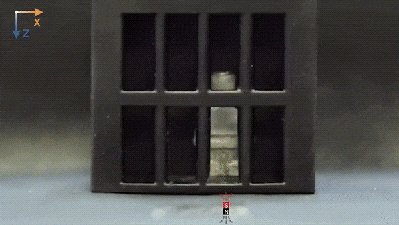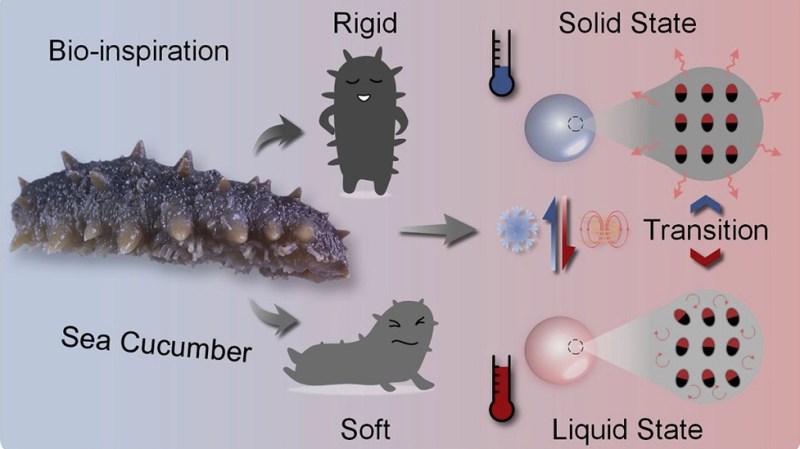Shape shifters have long been the stuff of speculative fiction, but researchers in China have developed a magnetoactive phase transitional matter (MPTM) that makes Odo slipping through an air vent that much more believable.
Soft robots can squeeze into small spaces or change shape as needed, but many of these systems aren’t as strong as their more mechanically rigid siblings. Inspired by the sea cucumber’s ability to manipulate its rigidity, this new MPTM can be inductively heated to a molten state to change shape as well as encapsulate or release materials. The neodymium-iron-boron (NdFeB) microparticles suspended in gallium will then return to solid form once cooled.

Applications in drug delivery, foreign object removal, and smart soldering (video after the break) probably have more real world impact than the LEGO minifig T1000 impersonation, despite how cool that looks. While a pick-and-place can do better soldering work on a factory line, there might be repair situations where a magnetically-controlled solder system could come in handy.
We’ve seen earlier work with liquid robots using gallium and bio-electronic hybrids also portending the squishy future of robotics.
Via ArsTechnica
















Looks like it is sadly too expensive to make sex toys out of.
Or an Implant..
It also takes a LONG time to go from hard to soft and on top of that, it doesn’t exactly get hard again the same way. Let’s not even get started on microparticles of neodymium-iron-boron probably not being the safest to touch mucous membranes.
Still a lot of progress to be made here but I guess even Terok Nor had to start somewhere too before it transitioned to staying deep at least eight or nine times. Though that begs the question, where was deep space six anyway?
Soft, rigid? Yeah, sure the “sea cucumber” was their inspiration!
Please do not put neodymium-iron-boron (NdFeB) microparticles suspended in gallium in your bottom.
“neodymium-iron-boron microparticles embedded in pure gallium”
Well that is an expensive combination.
Sounds slow too.
…and polymimetic liquid alloy sounds quicker?
And if it’s for drug delivery what is the toxicity of these metals in this application?
They’re just gunning for grant money. “drug delivery system” is an ancient way of making up a hypothetical market for your tinkering and getting people to give you more money for more tinkering. It’s never used for drug delivery. But you can get an infinite money hose-down from fake cancer charities which never ever produce any treatments. It’s a good gig if you can get it
Could be used for making artificial muscles, but the required heat dissipation would make it slow.
the T-1000 is coming :P
With the phallic innuendo in this article is that a single entendre or double?
would be more impressive if they showed it reform to its original shape, or any evidence that this was not just a magnet pulling an object into position, melting it, and then pulling the goop through the slot
although, knowing that a NdFeB suspension in gallium maintains its magnetic properties in both solid and liquid state could be a useful tool
Yeah, you can just barely see the mold for the minifig at the bottom of the GIF. It has a long way to go before it’s a memory alloy…
They always show such tech being used in a stomach but we all know they really plan to hand it over to the proctologists.
Ah, a horror movie then.
Yeah, and don’t get that molten gallium near any aluminum, or it would be..bad.
Have an enemy with an aluminum engine block? I have just the solution you need
Since HaD didn’t explain..
A low-melting-point solder is mixed with ferrous powder then placed over a grid of simple coil electromagnets.
The ‘cold’ solder can be moved around the grid by activating adjacent coils to step one grid space at a time, like a linear motor. The solder can be melted by applying an AC (instead of DC) signal to induce heat. the ‘liquid’ solder can’t be moved, just pulled slightly.
In the LEGO minifig video, the cage is tilted slightly down so that when the minifig melts, the solder flows into a minifig mold (how convenient). Once cool, the newly formed minifig is pulled up, toward the cage, by the electromagnets in the cage.
There is no ‘memory’ effect, no shape-shifting (beyond melting), the solder doesn’t move by itself, there is nothing novel here.
Thank you!